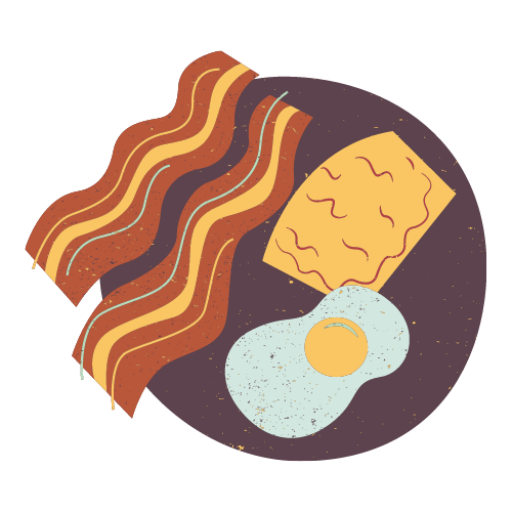In the early 1970s, Jack in the Box made a revolutionary move that would change the fast food landscape forever. The chain introduced breakfast to its menu, becoming a pioneer in serving morning meals at a time when most competitors focused solely on lunch and dinner offerings.
The Breakfast Jack, introduced in 1969, became the first breakfast sandwich offered by a fast food chain. This simple yet satisfying combination of ham, a freshly cracked egg, and melty American cheese on a toasted buttery bakery bun quickly became a hit among customers. The innovation filled a gap in the market, catering to morning commuters and breakfast enthusiasts alike.
Jack in the Box’s bold decision to serve breakfast set off a domino effect in the industry. Other major fast food chains soon followed suit, with McDonald’s introducing donuts in 1970 and the now-iconic Egg McMuffin in 1971. However, Jack in the Box maintained its edge by offering breakfast items around the clock, allowing customers to enjoy their favorite morning meals at any time of day.
The Origin of Jack in the Box

Jack in the Box emerged as a pioneer in the fast-food industry, revolutionizing drive-thru service and reshaping American dining habits. Its innovative approach and unique concept quickly gained popularity on the West Coast.
Robert O. Peterson’s Vision
Robert O. Peterson founded Jack in the Box in 1951 with a clear vision. He aimed to create a fast-food restaurant that catered to the growing car culture in America. Peterson’s concept focused on speed and convenience, targeting busy drivers looking for quick meals.
He introduced the novel idea of a two-way intercom system for ordering. This innovation allowed customers to place orders without leaving their vehicles, streamlining the drive-thru experience.
Birth in San Diego
The first Jack in the Box restaurant opened its doors in San Diego, California. Located on El Cajon Boulevard, it quickly became a local favorite. The restaurant’s unique drive-thru model set it apart from competitors still using traditional dine-in or carhop services.
San Diego’s car-centric culture provided the perfect backdrop for Jack in the Box’s growth. The city’s expanding suburbs and busy lifestyle aligned well with the restaurant’s fast-service concept. This initial success in San Diego laid the foundation for the chain’s expansion across California and beyond.
Jack’s Breakfast Revolution

Jack in the Box transformed the fast food breakfast landscape with innovative menu items and pioneering all-day availability. The chain’s breakfast offerings quickly became customer favorites and set new industry standards.
Introduction of the Breakfast Jack
In the early 1970s, Jack in the Box launched its first breakfast sandwich, the Breakfast Jack. This simple yet satisfying combination featured a freshly cracked egg, ham, and American cheese on a bun. The Breakfast Jack was an instant hit, appealing to customers seeking a quick and portable morning meal.
The sandwich’s success prompted Jack in the Box to expand its breakfast menu further. Priced affordably, the Breakfast Jack became a staple for commuters and students alike. Its popularity demonstrated the growing demand for convenient breakfast options in the fast food market.
Expanding Breakfast Offerings
Building on the Breakfast Jack’s success, Jack in the Box continued to innovate. The chain introduced items like the Meat Lovers Breakfast Burrito and the Ultimate Breakfast Sandwich. These hearty options catered to customers with bigger appetites.
Jack in the Box also added lighter fare, including yogurt parfaits and breakfast sandwiches on croissants. The diverse menu aimed to satisfy a wide range of tastes and dietary preferences. Notable additions included:
- Loaded Breakfast Sandwich
- Grande Sausage Breakfast Burrito
- Grilled Sourdough Swiss Breakfast Sandwich
All-Day Breakfast Pioneers
Jack in the Box made a groundbreaking move by offering breakfast items 24/7. This decision set them apart from competitors who limited breakfast to morning hours. Customers could now enjoy their favorite breakfast foods at any time of day or night.
The all-day breakfast concept proved immensely popular. It catered to shift workers, late-night diners, and anyone craving breakfast foods outside traditional hours. This flexibility became a key selling point for Jack in the Box, attracting customers seeking breakfast options throughout the day.
Other fast food chains eventually followed suit, but Jack in the Box remained a leader in all-day breakfast offerings. The chain’s commitment to serving breakfast around the clock solidified its reputation as an innovator in the fast food industry.
Menu Evolution and Diversity

Jack in the Box’s menu expanded beyond its initial breakfast offerings, incorporating a wide range of items to cater to diverse tastes. The chain introduced new flavors and cuisines, adapting to changing consumer preferences and market trends.
Beyond Breakfast Items
Jack in the Box rapidly diversified its menu to include lunch and dinner options. Burgers became a staple, with varieties ranging from classic cheeseburgers to more elaborate creations. The chain introduced tacos in 1951, which became an unexpected hit and remain popular today. French fries joined the lineup as a perfect side dish.
Chicken sandwiches appeared on the menu, offering a alternative to beef patties. The chain experimented with different flavors and preparations, from grilled to crispy options. Jack in the Box also added salads and sides to provide lighter fare for health-conscious customers.
Incorporating International Cuisine
Jack in the Box embraced global flavors to appeal to a broader audience. The menu began featuring items inspired by Mexican cuisine, such as quesadillas and churros. Asian-inspired dishes like egg rolls and teriyaki bowls made their way onto the menu.
The chain introduced fusion items that blended international flavors with American fast food classics. This approach resulted in unique offerings like the Chicken Fajita Pita and the Sirloin Swiss & Grilled Onion burger. Jack in the Box’s willingness to experiment with international cuisines helped set it apart from competitors and attract adventurous eaters.
Brand Identity and Advertising

Jack in the Box developed a distinctive brand identity through its innovative mascot, impactful advertising campaigns, and corporate responsibility initiatives. These elements helped shape the company’s image and set it apart in the competitive fast-food industry.
Mascot and Clown Head
Jack, the iconic clown-head mascot, became the face of Jack in the Box in 1951. Initially designed as a drive-thru intercom, the clown head evolved into a full-fledged character. In 1994, Jack was reimagined as a suit-wearing CEO, bringing a unique personality to the brand.
The mascot’s witty and irreverent demeanor resonated with customers, particularly young adults. Jack’s persona allowed the company to address serious topics with humor, creating memorable advertising moments.
Impactful Advertising Campaigns
Jack in the Box’s advertising campaigns often pushed boundaries and garnered attention. The “Jack’s Back” campaign in 1994 revitalized the brand after a food safety crisis. This series of commercials featured Jack as a no-nonsense executive, injecting humor into the company’s image.
The brand’s Super Bowl commercials became highly anticipated events. Notable ads included the controversial “Jack’s Encounter” spot and the “Marry Bacon” campaign, which capitalized on the bacon trend.
Jack in the Box also embraced digital marketing, creating interactive experiences and social media content that engaged younger audiences.
Rebranding Effort and Corporate Responsibility
In the early 2000s, Jack in the Box underwent a significant rebranding effort. The company updated its logo, restaurant designs, and menu offerings to appeal to a broader demographic.
Corporate responsibility became a key focus. Jack in the Box implemented animal welfare policies, improved food quality standards, and increased transparency in ingredient sourcing. The company also launched community initiatives, such as the Jack in the Box Foundation, which supports youth-focused organizations.
These efforts aimed to position Jack in the Box as a socially conscious brand, aligning with changing consumer expectations in the fast-food industry.
Franchise Growth and Expansion

Jack in the Box experienced significant franchise growth since its founding in 1951. The company expanded from a single location in California to become a major fast food chain across the United States.
From California to the Southeast
Jack in the Box began its expansion in California during the 1960s. By the end of the decade, the chain had grown to 180 restaurants. The company continued its rapid growth throughout the western United States in the following years.
In recent times, Jack in the Box has set its sights on new markets. The chain is actively pursuing expansion opportunities in the southeastern United States. This move aims to increase brand visibility and market penetration in previously untapped regions.
Jack’s Family Restaurants Footprint
Jack’s Family Restaurants, a separate entity from Jack in the Box, has established a strong presence in the Southeast. The chain operates numerous locations across Alabama, Georgia, Tennessee, and Mississippi.
Founded in 1960, Jack’s is known for its hamburgers and Southern-inspired menu items. The company has built a loyal customer base in these states. Jack’s Family Restaurants was acquired by Onex Corporation in 2019, providing additional resources for continued growth and expansion in the region.
Quality and Customer Experience

Jack in the Box prioritized quality and customer satisfaction as key drivers of success. The company implemented innovative strategies to enhance service, ensure food safety, and build lasting customer relationships.
Drive-Thru Service Innovation
Jack in the Box revolutionized fast-food service with its drive-thru innovations. In 1951, the company introduced the intercom system, allowing customers to place orders from their cars. This technology significantly reduced wait times and improved order accuracy.
The drive-thru service became a cornerstone of Jack in the Box’s operations. It catered to the growing car culture and busy lifestyles of American consumers. The company continuously refined its drive-thru process, optimizing speed and efficiency.
By the 1970s, drive-thru service accounted for a substantial portion of Jack in the Box’s sales. This success prompted other fast-food chains to adopt similar models, cementing Jack in the Box’s role as an industry pioneer.
Focus on Food Safety
Food safety became a top priority for Jack in the Box following a major E. coli outbreak in 1993. The company implemented rigorous food handling and preparation protocols across all locations.
Jack in the Box introduced a comprehensive Hazard Analysis and Critical Control Points (HACCP) system. This approach identified potential food safety risks and established preventive measures at every stage of food production.
The company also invested in employee training programs focused on proper food handling techniques. Regular audits and inspections were conducted to ensure compliance with safety standards.
These efforts not only improved food safety but also helped rebuild customer trust. Jack in the Box’s commitment to quality and safety became a key differentiator in the competitive fast-food market.
Building Customer Loyalty
Jack in the Box cultivated customer loyalty through its diverse menu offerings and unique brand personality. The introduction of breakfast sandwiches in 1969 catered to morning commuters and expanded the company’s customer base.
The brand’s quirky advertising campaigns, featuring the iconic Jack character, resonated with customers and created a strong emotional connection. These campaigns often highlighted the company’s innovative menu items and commitment to quality.
Jack in the Box also implemented loyalty programs and promotional offers to encourage repeat visits. The company’s 24/7 operating hours and all-day breakfast menu provided flexibility for customers with varied schedules.
By consistently delivering on quality, convenience, and innovation, Jack in the Box built a loyal customer following. This loyalty proved crucial in supporting the brand through challenges and driving long-term growth.
The Modern Landscape of Fast Food

The fast food industry has undergone significant changes since the introduction of breakfast items. Chains have expanded their menus and adapted to changing consumer preferences.
Fast-Food Chain Evolution
Fast-food breakfast has become a staple in American dining culture. Many chains now offer all-day breakfast options to meet customer demand. Menu innovations have led to healthier choices, including egg white sandwiches and fruit parfaits.
Drive-thru service has been optimized for faster breakfast service. Mobile ordering and delivery have further transformed the morning rush. Chains compete fiercely with unique offerings like breakfast burritos and specialty coffee drinks.
Customization options have increased, allowing customers to personalize their breakfast orders. Some restaurants have introduced plant-based alternatives to traditional breakfast meats.
Jack in the Box’s Place in American Fast Food
Jack in the Box remains a notable player in the American fast-food landscape. The chain’s introduction of the Breakfast Jack in 1969 was a pioneering move. This ham, egg, and cheese sandwich on a bun set the standard for breakfast sandwiches.
Jack in the Box continues to innovate with items like the Loaded Breakfast Sandwich. The company’s 24-hour menu availability gives it an edge in the breakfast market. Its mascot, “Jack,” has become an iconic figure in fast-food advertising.
The chain has expanded its breakfast menu to include items like breakfast burritos and croissants. Jack in the Box’s willingness to experiment with flavors keeps it competitive in the evolving fast-food scene.




